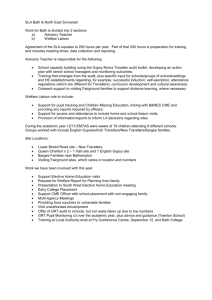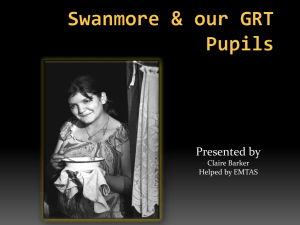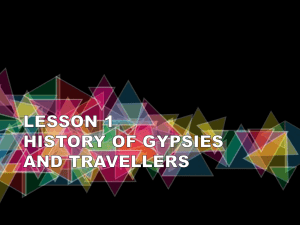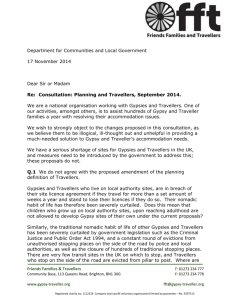The rise and roles of commercial travellers in Britain in the
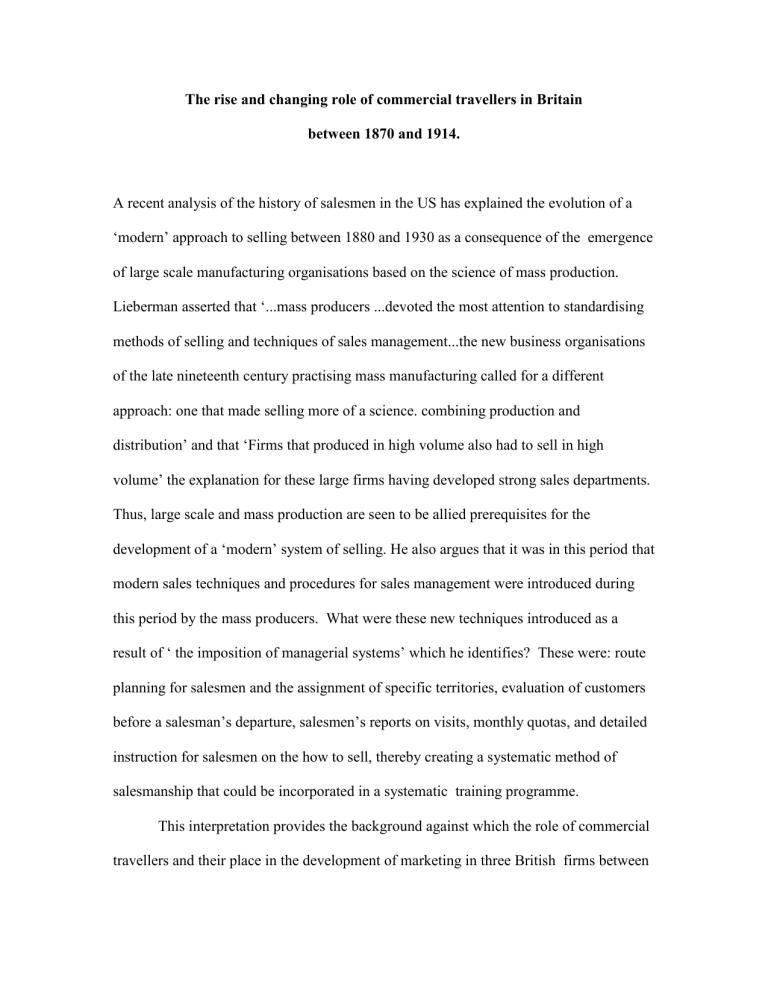
The rise and changing role of commercial travellers in Britain between 1870 and 1914.
A recent analysis of the history of salesmen in the US has explained the evolution of a
‘modern’ approach to selling between 1880 and 1930 as a consequence of the emergence of large scale manufacturing organisations based on the science of mass production.
Lieberman asserted that ‘...mass producers ...devoted the most attention to standardising methods of selling and techniques of sales management...the new business organisations of the late nineteenth century practising mass manufacturing called for a different approach: one that made selling more of a science. combining production and distribution’ and that ‘Firms that produced in high volume also had to sell in high volume’ the explanation for these large firms having developed strong sales departments.
Thus, large scale and mass production are seen to be allied prerequisites for the development of a ‘modern’ system of selling. He also argues that it was in this period that modern sales techniques and procedures for sales management were introduced during this period by the mass producers. What were these new techniques introduced as a result of ‘ the imposition of managerial systems’ which he identifies? These were: route planning for salesmen and the assignment of specific territories, evaluation of customers before a salesman’s departure, salesmen’s reports on visits, monthly quotas, and detailed instruction for salesmen on the how to sell, thereby creating a systematic method of salesmanship that could be incorporated in a systematic training programme.
This interpretation provides the background against which the role of commercial travellers and their place in the development of marketing in three British firms between
the 1870s and 1914 may be judged. How far do their histories fit the interpretation of the
‘birth of the salesman’ described in the US? A further question is whether innovations in selling were explicable in terms of corporate strategies and the entrepreneurial vigour of individual owners and managers; or whether it is possible to discern a pattern relating types of product and their market characteristics.
I
A consensus regarding the history of distribution in Britain in the early nineteenth century describes a traditional wholesaling system in which the warehouse was the central institution and the key figures were the merchant or factor, the warehouseman, and the bagman travelling the road.. Some of the large wholesalers employed commercial travellers, but unlike travellers later employed by manufacturers, they represented merchants, dealers, or factors who typically handled a wide variety of goods supplied by several producers, sometimes in competition in the same markets. Seeking orders and collecting payment were the travellers’ principal activities. During the third quarter of the century the system functioned in the textile, ready-made footwear, ironmongery, pottery, jewellery, rubber, and tinplate trades. With the exception of textles where the wholesaler continued to dominate trade, from the mid 19 th
century the agency system began to curtail the operations of merchants, dealers, and factors in those trades
It brought the manufacturer and the retailer closer together by limiting trading operations to a smaller range of goods, specialising in categories of trade, or even of products offered and sold on a commission basis agreed with the manufacturer. The advantages of the agency system, in which agents sold products on commission, are well known. It
minimised direct selling costs until after sales were made, which is why agencies were especially attractive to start-up and other small firms. Established wholesaling agents possessed trade connections which travellers would find difficult to build up quickly without the necessary introduction. As commission agents were dependent on sales for their remuneration, commission provided an incentive to approach the market aggressively. Trading through an agency avoided the overhead costs of an office staffed by clerks necessary for managers to plan, monitor, and control traveller’s activities.
The most detailed account of the advantages of trade conducted through an agency have been recorded by Payne in the trade in rubber mechanicals; however, these were intermediate products which depended on unambiguous testing of function unaffected by packaging or presentation. Popp has presented a contrasting picture in the pottery trade which reveals the weaknesses of the agency system; they included a wholesaler’s pre-occupation with prices and delivery and a lack of concern with the details of the pottery products supplied by individual manufacturers. He concluded that the system offered low transaction costs but inferior quality of information on markets, competition, and consumers . From the standpoint of a manufacturer, the most effective agent was one handling a single commission. This was an arrangement which offered low financial risks and the advantage of the agent’s connections. Ultimately, however, market-specific knowledge was best gained by taking over an agent. The activities of an exclusive agency resembled direct selling by commercial travellers. Evidence that manufacturers increasingly acknowledged this, particularly the larger manufacturers which could meet overhead costs of office and administration that a traveller force
1871
1881 involved, was presented to the Royal Commission on the Depression in trade and
Industry in 1886
‘The tendency is for the consumer to go more direct. We [warehousemen] at one time used to be the channel through which everybody had to obtain their goods, but now...the tendency is for the manufacturer to go more direct to the consumer; and a great many large retail concerns that used to be obliged to get their goods from us, now go direct to the manufacturer.’ Census figures suggest that from the 1870s the number of warehouseman fell at the same time as the agency system expanded. Commercial travellers increased at a greater rate, as did commercial clerks.
1891
1901
Commercial travellers
20730
40271
49868
74964
Agents and factors
23853
34512
40531
46819 commercial clerks
104969
208116
284097
402184 warehousemen
49562
35198
32220
19983
1911 98428 49255 546939 13834
The best evidence available on distribution in the period provides examples of effective agency (for intermediate goods) and unsatisfactory agency (for consumer goods). This raises the question whether an attempt to relate different types of products to optimal modes of distribution can help to answer such questions as:. Why did the wholesale and agency systems survive longer in some trades than in others? Why did manufacturers producing certain products abandon the wholesalers, factors, and agents
and employ travelling salesmen? Did the salesmanship function change during the second half of the century? Is it significant that the strongholds of the wholesaling and agency systems after 1870 were mainly the traditional sectors of industry dominated by apparel, metal, and jewellery trades? This paper focuses on trades in which manufacturers were among the first to employ travellers and who moved closest to consumers in the selling process: Reckitt & Sons, manufacturers of starch, washing blue, and polish; Lever Bros, soap manufacturers, and Burroughs Wellcome & Co., pharmaceutical manufacturers.
II
With the emergence of packaging and branding accompanied by systematic and sustained advertising from the 1840s, selling groceries, food and washing materials, began to affect relationships between sellers and consumers which had implications for the role of the commercial traveller. This was implicit in a letter written by Isaac Reckitt in 1851 to J. J.
Cousin, a Liverpool agent who applied to Isaac Reckitt & Son to become a commercial traveller.
‘We would point out that the trade you have been engaged in does not give you any experience in the sale of our goods but rather the reverse, as although you may know something of the grocery trade and competition, yet it requires so much more persuasion and talking to sell starches, blues, and black leads than it does to sell flour, that we are not sure that one would not somewhat unfit you for the other’. This was a perceptive observation which is consistent with economists’ analyses of relationships between
information and advertising, and which, we shall argue, can be extended to analyse the rise and changing role of commercial travellers in the nineteenth century.
Early in the history of the firm, the Reckitts decided that commission agents were expensive yet ineffective in ‘winning the retailers over’. Partly because of the cost of hiring from outside the family, the risk of embezzlement by strangers, and the problem of exercising control, the first three travellers to go on the road were of the Reckitt family, their youth occasioning soul searching among the Quaker partners. The risks involved were underlined some years later in connection with a young applicant to whose referee the manager, Thomas Ferens, replied: ‘I fear he is too young to send away from home unless he is prematurely ‘old’. There are too many temptations on the road.’
For a time, the Reckitts employed commission agents who dealt exclusively with the firm’s goods on del credere terms which made the agent personally responsible for all debts. Commission levels were between 10 and 15 % on the prices of goods fixed by the partners. When the partners switched from commission agents to salaried travellers recruited from outside the family they also introduced financial security guarantees. On appointment, each traveller was required to lodge a deposit of between £100 and £200, which in several case was put up by a family member or by the Guardian or Provident
Clerks’ Society.
Security guarantees were important because of risks originating from two sources: customers and the travellers themselves. When Barber was engaged to develop new ideas to break into the London market in the 1850s, he was told that great care should be taken in opening new accounts: ‘Do not let their anxiety to sell induce thee to push with unsound money, better to send fewer orders and safe...for the former will sure to end in
loss and disappointment to both thee and thyselves. Unsafe men always order heavily’.
Travellers’ misappropriations involved the submission of false orders, selling stock under price, leaving lodgings in debt, false charge for rent. The recruitment of travellers who could be trusted, therefore, was of prime importance. Most recruited from outside the family became known to the Reckitts either as sons of customers or of Friends from the widespread Quaker network to which the Reckitts belonged. Several possessed a commercial background or experience.
The capacities and qualities sought in travellers remained consistent: energy, perseverance, respectability, ‘a gentlemanly style and address’, and no eccentricities.
Applicants’ referees were asked whether the aspirant was ‘strictly honourable, sober, and of good moral character’. Those either suspected, or known to have been consumers of excessive alcohol were required to take ‘the pledge’ before being accepted, or re-engaged but on a commission only basis. For whatever reason, a high turnover of travelling staff was undesirable in two respects. It interrupted the regular pattern of three to four monthly visits to retailers by the traveller in whose territory they were located.
Potentially more important, however, was the knowledge of the business of the company and trading connections which departing travellers took with them, which explains why each was required to sign a contract including an undertaking that ‘After quitting
Reckitt’s employment to refuse for twelve months to enter into the service of any person whatsoever carrying on the trade... in Great Britain and Ireland’, for which the penalty was an agreed £100; such agreements were still in use in 1910.
What did travellers do?. Until the 1870s, travellers were responsible for visiting retailers to take orders from existing customers or called upon new customers to
introduce products. Collecting debts was an important task, especially for the small firm struggling with liquidity. The incentive to travellers to push goods was a guaranteed salary plus travel expenses and allowances for lodgings or hotel accommodation, plus commission. Salaries were based on historic levels of sales, or in new areas on partners’ perceptions of what constituted a reasonable level of sales (and level of commission attainable) in the light of population size and the balance in the market between middle and working classes and the poor. Commission levels differed from one product to another and were fixed according to the company’s priorities in pushing, or the difficulties in selling, the range of items on offer, typically varying from 5% to 15%.
Earnings ranged between £200 and £800.
Beginning in 1870, an extension of the travellers’ function began to occur which later saw a division of labour to effect the successful new strategy. This process originated from George Reckitt’s ‘missionary plan’, a consequence of his own experience on the road which had convinced him that retailers were insufficiently receptive to new products. By combining simultaneous sustained advertising with visits by travellers, not only to retailers but also to washerwomen and housekeepers, his intention was to ‘force the shopkeepers to [order] for we shall talk over his customer...and he must then get it or let people go elsewhere’. In an environment of increasing competition, the development of new products, and product differentiation, the ‘missionary policy’ was put in place.
The occasion was the launch of Paris Blue, a high quality clothes whitener, samples of which were distributed to laundresses who were urged to use and compare with the use of twice the quantity of indigo to achieve the same effect at a lower price. A first print run of 200,000 washing books, compact manuals of laundry practise and household
management, accompanied samples distributed to retailers and selected laundries. They proved so popular that Reckitt’s travellers sold the books at a profit. An enlarged edition appearedin 1873 followed by A
Grocer’s Handbook.
For the purpose of advertising using enamelled advertisements, contracts were aimed at securing space on one quarter of all omnibuses and carts in London. Outside London, bill posting policy was to secure exposure on every billboard in the country. Both were part of the Reckitts’ philosophy ‘to constantly keep our name before both the consumers and dealers’.
Sampling and house to house visiting necessitated an expansion of the travelling staff. Whereas introducing products either to householders or laundresses, or to the small retailers in smaller towns which the partners now began to reach out to required a degree of salesmanship, the distribution of samples was an unskilled task. The solution was to create a sub-traveller status called an introducer. Introducers’ work, described as of a secondary character, was to distribute samples house to house, calling on laundries to demonstrate the use of one of the company’s products, either starches, washing blues, or black lead polish. Introducers were also required to call on shops in areas where the company’s products were not being sold. ‘Special travellers’ were another group within the sub-traveller category whose task it was to distribute showcards to small shops and to distribute samples to consumers. Repeat orders from these small shops were to sustain sales without the repetition and cost of the one-off sample distribution. Assistant travellers fell into the same sub-traveller category but were the result of the initiative taken by senior travellers responsible for trade with the principal retailers in London and urban districts in the regions, although their duties also overlapped with those of introducers. In 1879, the Birmingham representative persuaded the Reckitts that he
should be permitted to employ an assistant because of the heavy demands on his time servicing retailers already loyal. Under the new agreement, the assistant was to spend between 1/2 and 2/3 of his time on the regular trade. His payment was £100 plus travel expenses deducted from Payne’s commission on the orders secured by the assistant. A supplementary payment was to be made by the company for the time occupied in advertising, by issuing circulars and other matter, and house-to house visiting. Office managers, however, insisted on controlling the sub-travellers, even though most of their remuneration came from the traveller. When one traveller hired and subsequently fired an assistant without informing the management, he was reminded that ‘several of our representatives have had curates whom they have paid out of commission but they have always been our servants’. The further development of this trend towards a division of the salesmanship function is illustrated by the situation in the West Riding district in
1900 where under the management the senior traveller seven introducers worked in his area, spending an evening each week with him to discuss their orders and to receive encouragement.
When new products were launched, introducers were deployed in large numbers.
They were referred to as gangs, each typically consisting of several ‘smart bright boys’ supervised by a ‘ tried man’ as inspector. In the case of the launch of Zebra grate polish in 1890, Sheffield, Bradford, and Leeds were the first to be targeted for the distribution of samples to the best houses in residential districts. Working class houses were ticketted, tickets redeemable at the local grocery store. A refinement was to distribute larger samples to all houses employing servants and to the larger houses, the logic being that the
1d packet samples would be inadequate evening for one morning’s wash and would
therefore be mixed with whatever polish was already in use. Other sub-travellers were employed to combine visiting small shops with the supervision of advertisements, including the maintenance of glass and metal tablets, within a district. Servicing the tablets, changed every three months, re-painted and maintained, was undertaken by a body of ‘renovators’ employed by the company.
In addition to intensive introducing activity at the launch of new products, gangs were similarly deployed, supported by heavy local advertising, in districts where a competitor was making a determined attack on a Reckitt stronghold or in towns where the competitor was strong. Thus, in 1901 travellers and introducers were instructed to ‘show the unprofitable character of the Enameline scheme to the trade and concentrate effort on paste in localities where Enameline is largely sold’. Robin Starch, launched in 1899, received similar support from advertising, travellers and introducers combined with a heavy advertising campaign. in an attempt ‘to make the term Robin and starch synonymous’.
Travellers at all levels were also expected to report on competitors’ activities. In
1883, Francis wrote to James regarding their major competitor in the starch trade, J. & J.
Colman: ‘We are getting all the information we can, in a quiet way, through the travellers’. When James Mann, formerly employed by the Bishop Auckland Cooperative
Store working the colliery villages, applied to become an introducer, he was asked first to secure a sample of members’ grocery books from which the Reckitts discovered the
Coop’s success in supplying large volumes of starch, blue and black lead to the houses of pitmen and engine drivers. Mann was engaged ‘to pursue this inquiry’. The new development of metal polishes also owed much to the intelligence collected by Reckitt’s
travellers who in 1902 made inquiries regarding the new Globe and Shine metal polishes that entered the market. Their information led the directors to conclude that a good opening existed for a first class metal polish; the result was Brasso, which quickly became one of the company’s leading products.
Control over salesmens’ activities was initially the responsibility of the partners, during which time the monitoring of their performance was informal, though persistent.
From 1868, this task fell to Thomas Ferens, appointed confidential clerk to James
Reckitt. Under the new system his prime responsibility was to make out their commission accounts, keep a set of books and to analyse sales in terms of product, region, and the individual traveller responsible. Such data led to the adoption of certain principles affecting advertising, for example relating expenditure to the number of inhabitants (£100 per 20,000 in 1891), and to a recognition of the potential for market research It was Ferens, also, who looked to the American success of Quaker Oats and of
Lever’s Sunlight Soap as the model for marketing strategy. In relation to the launch of
Robin Starch, he observed that the Zebra campaign had taught much: ‘Before our big competitors were awake and had overcome our propaganda in favour of their own we could make our position like Sunlight Soap, practically impregnable’.
III
While the Reckitts pioneered systematic sampling and were among the leaders in advertising, the massive scale and success of Lever’s launch and sustained campaign to promote Sunlight soap explains why, by the 1890s, Ferens regarded Lever Bros. as the most effective selling organisation in Britain. None of William Lever’s methods were
new when he registered Sunlight Soap as a trade mark in 1875, nor in 1886 when he commenced the manufacture as well as sale of packaged soap. The pace and scale of his expansion, however, was dramatic. Between 1877 and 1904, the number of travellers employed rose to 100, each servicing 500 customers. Following the Reckitts, Lever employed assistant travellers, district agents, gangs of introducers for sampling and ticketing, sustained advertising in different media, handbooks for the trade and for the public, and the monitoring and control over travellers’ activities administered through a central office. The American influence on Lever was in part the result of the influence of
Goss, the American general manager of Lever’s organisation in London. ‘Progress’, an in-house magazine produced first in 1899, had an educative function which included reports on selling activity, advice to outdoor salesmen, and the etiquette to be observed when approaching consumers. It also included an exhortation, clearly influenced by
American sources, to salesmen: ‘Ding dong every day, every hour, every minute, that’s the way to success and happiness’ Apart from the sheer scale on which Lever operated, the main differences appear to have been Lever’s scheme of prizes for wrappers (which was a short term success but ended in failure when competitors introduced their own schemes and withdrawal). Later, he likened prizes for wrappers to dram drinking:’it appears most efficacious at first, but loses its effect after a time’, but he also described the prizes offeredby the company as ‘little better than rubbish’. The early years of the twentieth century saw refinements introduced in the continuing attempt to get close to the consumer for a persuasion crusade. This began following Lever’s discovery reported in
1903 that one northern soap maker was attacking the Leeds market with twenty district agents ‘going from house to house, preaching the infallibility of their own firm’s soap
and pointing out the heresy and danger of Sunlight, and especially that Sunlight is only
12 oz to the lb. That at present is the parrot cry throughout these districts. These firms must be having better experience than we did with our district agents’ (which Lever had recently withdrawn). District agents might become assistant traveller if they merited promotion Meanwhile, other northern soap makers had introduced a new tactic in their distribution policy. A gang was sent into a district to call on grocers’ shops where instead of ticketing or sampling they purchased soap tablets from the retailers at full price. This was then sold to customers from door to door, the district agents returning to the grocers’ neighbourhood to replenish supplies, which proved to be a popular policy among grocers. Lever’s response was to estimate the cost of this exercise. :’I calculate that the half hour or twenty minutes occupied by selling a bar of soap by conversation to a woman at a door is bad business from the manufacturer’s point of view and that it costs
1.5d to 2d per tablet to sell in this way unless a canvasser happens to call on a householder who requires no persuasion and who might take two or three tablets’.
Instead, he recommended a policy of distributing the full-sized tablets free to householders in certain districts, a task which could be carried out by a gang between one half and one tenth of the time taken for door to door selling. The cost per tablet of such an exercise would be higher, but the result would also be to place soap in the hands of those who had not been disposed to buy it and who might become users. Goss agreed in principle, but believed that employing boys for such an initiative would be unwise, even though, as Lever pointed out, boys were cheaper, even when accompanied by an inspector to supervise the gangs. Gross argued that ‘picking up boys in a haphazard way to employ on handcarts’ was inadvisable because neither boys nor men in such gangs
should make household calls involving conversation with the householder;’...men and boys are not always of good address..Youths are more likely to take liberties and commit vulgarities than men who, when chosen from the respectable class we have no complaints’. Lever conceded that although he favoured using boys, who he thought women preferred to call and were cheap, that men were more reliable, dependable, and received training. From this body the best and most trustworthy were selected to send, sometime alone sometime in pairs, to the smaller places where sending the gang as a whole would be too much.’ The policy adopted removed from the travellers and branch managers the responsibility for masterminding the gang work, which henceforward was centrally planned and monitored. The travellers were, however, expected to provide feedback on the impact of the 50 gangs mobilised for 26 weeks for the free distribution of full sized soap bars: 8.4 million sample tablets covering 30% of all householders. The issue whether to employ men, or boys under supervision was settled by Lever who decided that the same criteria should be employed when appointing men and boys. While
Lever spent increasing amounts on advertising, imitating the American approach by investing each product with a personality, he regarded the public as 'about as dense as granite rock and just as hard to penetrate’. He drew Goss’s attention to evidence for ‘the remarkable influence of travellers’ in the history of Watson’s, a major competing soap maker. Lever regarded Watson’s to be ahead of his own company because ‘they overmatched us with salesmen, even though we overmatched them with advertising and the quality of our soap’. He concluded:’We can only be solid with good men in every district, trained to their work, and backed by the best advertising that we are capable of and a definite policy behind every soap’.
III
Such a statement could equally have been made by Silas Burroughs or Henry
Wellcome describing the policy which they adopted for Burroughs Wellcome & Co., the pharmaceutical company set up by the two American pharmacists in London in 1880.
However, a brief review of their approach to selling medicines provides some instructive contrasts with those of Reckitt and Lever Bros. By definition, ethical medicine could not be advertised directly to the public, consequently the direct route to the consumer adopted by Reckitt and Lever Bros. was not open to BW&Co. Producers of fine chemicals in
Britain advertised in journals to the medical profession and to chemists and druggists.
The advertisements consisted of informative rather than persuasive copy containing limited claims, to treat or at most alleviate, rather than to cure, various conditions. None employed travelling salesmen. Burroughs and Wellcome adopted the British manufacturers’ approach to advertising, but employed American-style ‘detail men’, their own occupation in the US before coming to Britain. ‘Detailing’, was the practice whereby representatives called upon doctors, as well as chemists and druggists, to explain in detail the contents and characteristics of the product they were promoting for the firm, to outline its advantages and effectiveness and, in principle, taking care not to advance exaggerated claims. Although during the early years the recruitment of salesman possessing training similar to that of the partners or cognisant of drugs and pharmaceuticals proved difficult to achieve, this was their continuing aspiration. It was achieved to some degree by the late 1880s, after the partners had established a reputation for the quality and reliability of their innovative compressed medicines imported from
their former employers, both among medical practitioners who valued accuracy of dose, palatability, and portability, and among traders as an increasingly valuable source of profit. The key to growing sales was the cultivation of medical practitioners who were visited in their hospitals and consulting rooms and in their general practices of a trust, within which the credibility extended to travellers enabled them to introduce new and modified medicinal products and dietetic goods. Not all doctors were familiar with recent developments in medicine and not all chemists were familiar with recent developments in pharmacy. However, so long as the partners ensured that they, themselves, were, and that their travellers were briefed to conduct their interviews equipped with sufficient knowledge to gain the confidence of the knowledgeable practitioner, at least some proportion could be expected to follow best practice of the leaders. This proved to be the case with respect to compressed medicines under the
Tabloid trade mark, which during the1880s became synonymous with tablets, and
Kepler’s Cod Liver Oil and Malt Extracts, a dietetic food sold in exactly the same manner as ethical medicines.
.
A high turnover of travellers is evidence of the partners’ difficulty in recruiting sales representatives, principally because they sought men qualified in, or at least possessing sufficient familiar with, pharmacy or medicine to enable them to speak knowledgeably to medical practitioners and pharmacists. Salary and commission for travellers could exceeding average earnings of dispensing chemists (of between £120 and
£140), while the most senior travellers earned three to four times that, probably
exceeding the incomes of at least 50 per cent of all doctors. Like polish and soap, medicine was a consumer good. However, selling medicine was different in several important respects, not least because the purchase of prescription medicines depended less on consumer choice or recommendation by chemist or druggist, but on the decision or advice of a medical practitioner. The partners developed a formula for connecting dispensing chemists with doctors, for gaining access to hospitals and consulting rooms, and for the conduct of interviews. The tactic adopted was to call first on the retailer to persuade him to allow the traveller to refer to him later, when in conversation with the doctor, as the company’s agent. Prescriber and dispenser were thus connected. The canvassing of hospital doctors and surgeons was conducted in hospitals, rather than at their homes where they saw private patients. One reason was that the doctors were assembled in the same place and therefore were more accessible, particularly if access could be gained to the private room where they usually gathered to chat at the end of the day; Burroughs explained to Wellcome that ‘The time of a London doctor which at hospital is nothing to him is worth a guinea a minute’ [in private consulting rooms]. The second reason was that he had found doctors to be more likely to try novelties on hospital than on private patients, partly because of the hope that reports of tests might be published. The hospital apothecary was also considered to be a key to making appointments to see all the leading surgeons and others at convenient hours.
From the beginning, the partners’ approach to countering potential hostility to the novelty of American preparations was a systematic sales campaign incorporating an early form of market research well before those introduced by either Reckitt or Lever Bros.
Under the new system every traveller was issued with a pro forma questionnaire which,
on completion, was transformed into a consolidated compilation. Each time a traveller returned from a tour of his territory, the reports, completed by the use of ticks, crosses, and code letters, were submitted to the partners to assist with their analysis of the market and decisions on policy. The questionnaires for doctors were slightly different from those issued for use when visiting chemists, but the intention behind both was the same. After entering the name of the town, its occupational characteristics, population, and the number of medical men resident in each location, travellers were asked to list the ages of those visited, their specialities, whether they wrote or dispensed, and the class into which their practice (presumably judged by class of clientele) fell: ‘common’, ‘moderate’, or
‘toney’. Presumably measured by size as well as clientele, travellers were also invited to rank doctors by ‘class of practice’ from A1 to 4. Questions were included to gauge responses to receiving a visit from the company’s travellers, whether cordial, good, indifferent, uncivil, or refusing an interview. Similar questions elicited attitudes to the products offered by BW&Co., whether they were pleased, had used, would or would not use, indifferent – or whether a response merited the description ‘old fogey’. Finally, the questionnaire sought to judge reactions (especially those of doctors) to travellers who left samples. Were they pleased? Did they regard it as a questionable practice? Were they non-committal? Space was provided for general observations..
The number of doctors visited each year between 1881 and 1885 was roughly
1700 . An indication of the coverage which these figures represent is that by October
1883 Wellcome claimed that in every town where at least two medical men resided, visits had been made by a traveller and samples had been distributed. Doctors in remoter parts had also received samples, though without a visit. The responses suggest the existence of
a profession willing to receive visits from travellers and willing to accept samples of new products, the main features of the new method of marketing drugs. Either this indicates a profession not resistant to innovation, or is a tribute to the effectiveness of the company’s travellers. In the case of chemists and druggists, of whom roughly one thousand were visited each year between 1882 and 1886, travellers were asked to classify businesses according to whether the shop was fine or common (those categories visited were roughly equal in number) and whether they displayed (or would be willing to display) BW&Co. showcards. Chemists were ranked on a scale A1 to 4 to which was added the request to identify ‘the leading man’ in each district. The shops of retail chemists, doctors’ surgeries, and hospitals were not the only targets for the partners’ carefully constructed marketing strategy. A list of customers receiving between 20 and 33.3 per cent. discount on bulk orders by the 1890s also included infirmaries, hospital schools, orphanages, Poor
Law Unions, prisons, Boards of Work and Guardian institutions, missions and missionaries, mining and exploration companies, and manufacturers or dealers in photographic goods.
The company’s travelling sales representatives were well aware of their importance. Addressing his fellow representatives in 1907, one of the most experienced travellers described them as ‘the eyes of the firm’. As such they were able to support implementation and monitoring of the price and substitution campaigns, but Rogers noted that travellers were also ‘constantly seeing the work and ideas of others as we move about. Let us study the methods of others and report from time to time on all new ideas and even the success of old ones.’ Curry, an experienced representative, was appreciative
of the benefits they enjoyed through the support they received from head office which afforded them a significant advantage compared with their counterparts employed by other firms. Travellers working for BW&Co. received adequate preparation for visiting through regular briefings to discuss with chemists the links between the company’s products, the chemists’ trade, and local dispensary practices, and to interview medical practitioners. The office regularly issued confidential ‘push lists’ of products and a confidential monthly letter circulated to all representatives setting out ‘selling points’ or
‘points for propaganda’ to assist them when introducing new products or re-launching those already established.
The long-established system of detailed monitoring of representatives’ activities by the partners was reformed in 1895, when travelling representatives were required to communicate with the general manager through a newly-appointed sales manager under whose command was a central sales who drew up monthly reports on the respective territories for which each was responsible based on detailed correspondence received from representatives on the road. On the outcome of his final scrutiny depended whether individual travellers received, encouragement, advice, reprimand, salary increase (or decrease), promotion, or were dismissed. Praise was awarded for ‘well phrased letters’ whereas those which fell below the company’s standards for grammar, spelling, relevance, and meaning were subjected to criticism, Fewer than 45 visits per week was barely acceptable; those lasting more than 20 minutes were regarded as excessive because: ‘. . . between 15 and 20 minutes impressive conversation with a medical man has much better results inasmuch as the doctor is thoroughly impressed with one or more
... products and is more likely to prescribe same than in a longer interview of one hour
plus which usually ends in the medical man having a hazy idea of 20 different things and no distinct recollection of one’.
The company introduced two-day annual training conventions attended by all home representatives, office sales staff, and managers. Meetings provided a forum for the exchange of information, experience, and ideas. The introduction of diphtheria antitoxin in the mid 1890s and other bio-medical products marked a conceptual shift because of the difference from all other known therapeutic methods, a change which presented a challenge to educate practitioners by first educating salesmen. The introduction in 1902 of Wellcome Brand Chemicals also required increased scientific knowledge in the marketing of drugs. Annual conferences provided a forum for education and discussion focused on the company’s new products, Scientists from the laboratories lectured on new therapeutical developments and drugs. Supported by advertising and special publications aimed at medical men, it was the travellers’ task to persuade physicians and pharmacists that the new therapies offered were both benign and user-friendly. The delivery of educational propaganda required not only scientific input in the preparation of advertising material informed by scientific knowledge and understanding, but a style of presentation intended to render the innovations comprehensible during the course of a one to one interview. Travellers reported a widespread ignorance among physicians, many of whom professed to know a great deal but who displayed a lack of understanding of pharmacy of even the crudest kind. However, travellers were advised to avoid revealing that ignorance when introducing new products, and to refrain from condescension when dealing with chemists and druggists, who instead should be encouraged to develop a more active approach to selling through displays of every kind.
The main strategy recommended by the senior traveller, X Curry, was that of
‘propagation’ (not to be confused, representatives were told, with selling), which he defined as ‘enlightened demonstration work’. His thesis was that hitherto the sheer novelty of the company’s products could impress doctors through show and tell. In an increasingly competitive environment he urged all representatives to devise ‘spectacular and picturesque’ demonstrations of selected products which could be carried in the traveller’s bag. Among the examples offered were those combining typical patter
(including diversionary content) with a conjuror’s adroitness, subterfuges intended to convince observers of the rapid solubility of certain products or their palatability deploying methods by which doctors could be persuaded to smell and taste new preparations. In 1907, the company introduced a policy of organising its own exhibitions in selected towns at which technology was employed to engage the interest of doctors and chemists through practical demonstrations. At the exhibitions, Curry used an insufflator with which to ‘blow a little snuff up the doctor’s nose’, a ‘cascarometer’ devised for the purpose of revealing the difference between the disintegrating properties of Tabloid Cascara and that of other brands; a ‘polariscope’, which showed the difference between atropine sulphate purchased on the open market and the Wellcome Brand, and the ‘bismuth barometer’, designed to make similar comparisons. Curry observed that
‘...by the time he has had a pinch of Menthol Snuff, tasted Alaxa, Tabloid Pastilles, cascara in different forms, Vana etc., he goes away with a good working knowledge of some of our products’. Propagation, in effect, added guile to the appeal of the scientific basis of BW&Co.’s products and the trust which Wellcome carefully constructed based on the Wellcome laboratories and through the scientists employed therein.
IV
There are striking similarities between the three manufacturing firms. Each sold nondurable consumer goods, spent heavily on advertising, employed travellers, and through division of labour and specialisation developed new selling strategies which involved direct contact with consumers or, in one case, those who took decisions which determined consumers’ purchases. In these respects the firms were innovators. Such innovations in marketing did not occur in the industries which predominated during the industrial revolution. Why not? Is it possible to discern a pattern of development amenable to analysis beyond that based on comparing corporate strategies and the entrepreneurial vigour of individual owners and managers? Is it possible to suggest why the innovations occurred in these markets rather than in others and explain differences discernible between different markets? And how far do the histories of these firms fit the interpretation of the ‘birth of the salesman’ described in the US?


